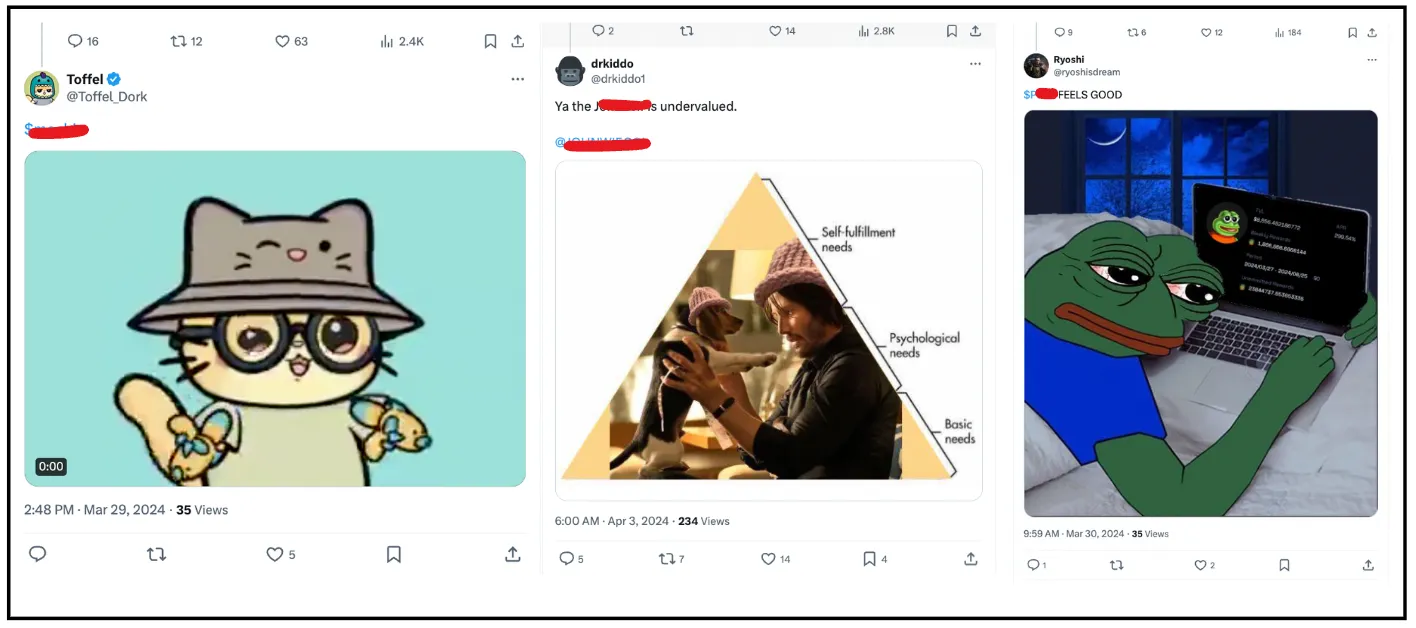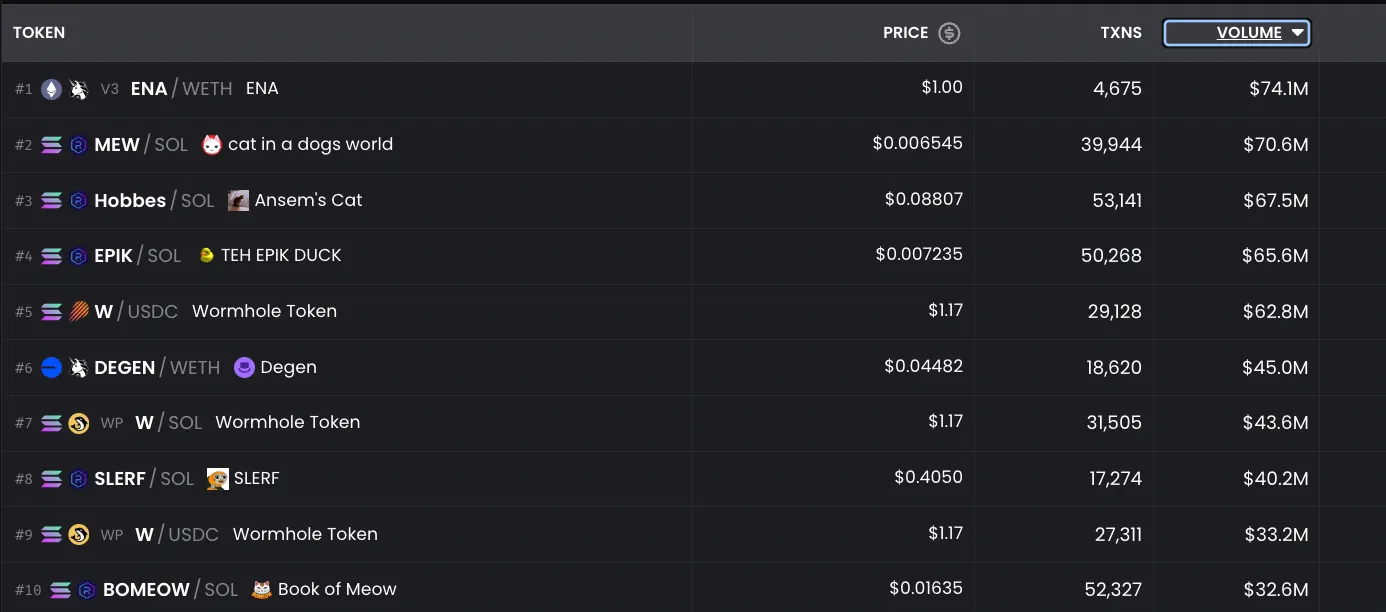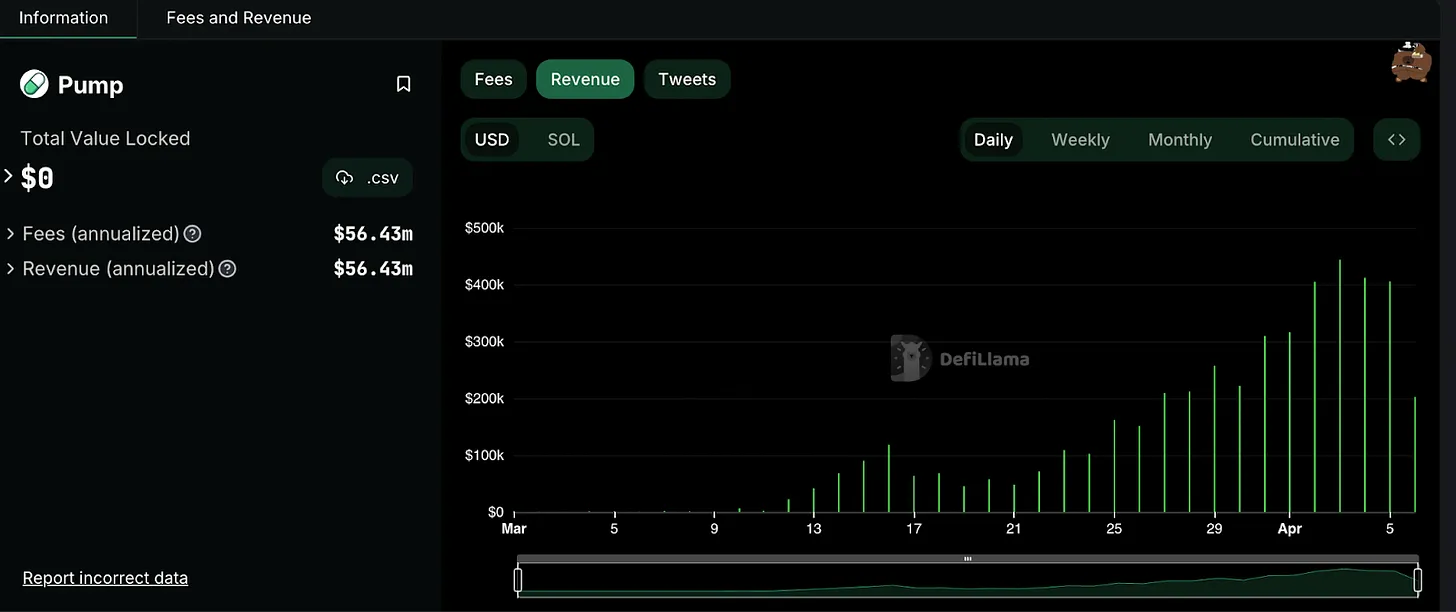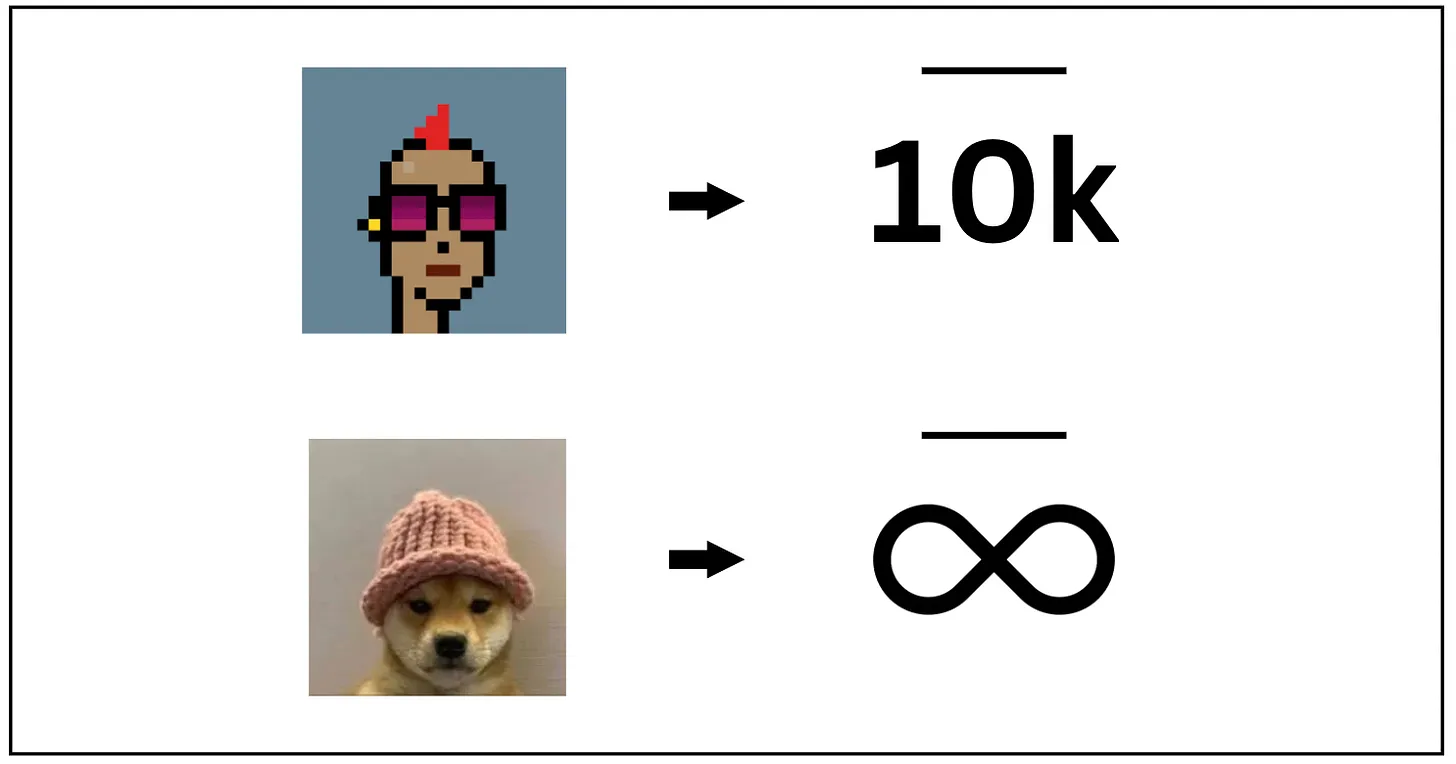Pantera Partners: Memecoin is the Trojan horse of cryptocurrency
Original Author: Paul Veradittakit, Partner at Pantera Capital
Translated by: Luffy, Foresight News
Meme is defined as a unit of cultural ideas transmitted between people. For the past decade, memes have been deeply intertwined with crypto culture.
The first Memecoin (Dogecoin) was launched in 2014 as a humorous derivative of Bitcoin, reaching a peak market cap of $75 billion during the bull market in 2021.
Recently, the meme coin market has experienced explosive growth. In less than a year, the market cap of the ERC-20 token (PEPE) surrounding Pepe The Frog skyrocketed by 400%, reaching $2 billion. Another meme coin (DEGEN) depicting a purple top hat, launched on the decentralized social network Farcaster, has surpassed a market cap of $1 billion, exceeding Farcaster's own valuation. Finally, a dog meme (WIF) wearing a beanie has gained fame on crypto Twitter through viral spread, with its price surging over 20 times since the beginning of this year, currently valued at around $4 billion.

Memecoins will continue to exist, and this article will explore the reasons why. We will provide a framework to better understand Memecoins, examine the infrastructure supporting their continuous development, and discuss how they significantly enhance network participation.
Memecoins Depend on Attention
A key realization is that Memecoins thrive on attention. In the world of Memecoins, attention is everything. Attention drives community behavior, hype, and the price movements of Memecoins.
You often find the comments section on Twitter filled with people promoting Memecoins. This behavior stems from a simple fact: the price of a Memecoin ultimately depends on the level of attention it receives. The more attention a Memecoin garners, the more potential buyers there are. If the relevant meme is interesting, these potential buyers are more likely to make a purchase.

Community members promote memes to attract attention to the Memecoin
In addition to sharing memes on social media, Memecoin enthusiasts come up with various creative ways to attract attention to their tokens. For example, the WIF community raised $700,000 for an initiative aimed at showcasing their meme on the iconic Las Vegas Sphere. As a result, anticipating that this publicity stunt would create a buzz, the token's value surged by 25%.
Sometimes, memecoins leverage existing attention rather than generating attention themselves. For instance, while prediction markets like PredictIt and Polymarket allow users to bet on presidential election outcomes, the attention-based "Politifi" memecoins developed around presidential candidates are designed to speculate on public interest in the candidates. As the 2024 elections approach, speculation and prices for these "Politifi" memecoins have surged.
So which Memecoins perform well? The answer is the tokens that people believe will attract the most attention.
The Importance of Distribution
When evaluating Memecoins, token distribution is a key factor for many potential buyers.
Some Memecoin projects decide to reserve tokens for the team and other plans. In addition to airdropping to community members and developers, many projects also choose to set aside a portion of tokens for marketing plans, teams, and DAOs.
Reserving part of the supply can create stronger incentive mechanisms and increase the chances of long-term success. By allocating vested tokens to themselves, teams are motivated to engage more with the project and ensure the token's success in the long run. Additionally, DAOs can be used to fund large initiatives.

Memecoin DAO governance initiatives
Other Memecoins, such as WIF, may be considered "more organic." While this strategy may make funding initiatives and project marketing more challenging, fair distribution remains a key factor in the popularity of many Memecoins.
Memecoin Trading Creates Huge New Market Opportunities
The Memecoin market is becoming enormous. Currently, the top 10 Memecoins have a combined market cap of over $50 billion. The on-chain trading volume of Memecoins is substantial, with over $1 billion in daily trading volume on Solana primarily driven by Memecoins.

Memecoins account for a significant portion of the top 10 tokens by daily trading volume. Source: Dexscreener
As a result, there are valuable market opportunities for developers. Tools and applications catering to the creation and trading of Memecoins have gained significant attention. For example, Bonkbot is a simple Telegram trading bot that makes it easy to trade Memecoins on Solana. In just five months, its revenue has exceeded $23 million.
Platforms like Bonkbot not only make trading Memecoins increasingly easy but also build infrastructure to simplify the process of launching Memecoins. To launch a Memecoin, it typically requires creating a token, using their funds to establish liquidity pools on decentralized exchanges like Uniswap or Raydium, and marketing the project.
Pump.fun is a platform that allows users to launch Memecoins with one click, and thousands of users have already used their platform to launch and discover the latest Memecoins. Currently, it earns hundreds of thousands of dollars daily through trading fees.

Pump.fun daily revenue, Source: DefiLlama
Memecoin Super Distribution
Memecoins combine the fun of sharing memes with economic incentives to encourage purchases, turning ordinary memes into "super" memes. The community behind the first Memecoin was incentivized by token ownership, elevating the Doge meme into a movement that attracted figures like Elon Musk. Understanding and applying the incentive-driven mass distribution characteristics of Memecoins can not only enhance memes but also drive other areas of cryptocurrency.

Memecoins accelerate the spread of memes through incentives
One area that can leverage Memecoin properties is NFTs. Currently, most NFTs perform poorly during bear markets. Why? Because they face distribution issues.
While the scarcity of NFT collectibles makes them excellent luxury assets, only a limited number of participants are motivated to raise the profile of the collectibles. Avatar collectibles like Cryptopunks have a supply cap of 10,000, serving as a prestigious status symbol. However, the same cap limits the fan base to a maximum of 10,000 people, restricting the broader participation and visibility that Memecoins enjoy.

Memecoins are fungible tokens, so their holder count is not limited
The introduction of ERC-404 provides a creative solution to the NFT distribution problem. ERC-404 is a new standard that facilitates fractional ownership of NFTs. Projects like Pandora, DN-404, and Asterix are pioneering this space, allowing NFTs to be divided into multiple shares (which you could call Memecoins if you wish). This means that a single NFT traditionally owned by one person can be split into multiple parts. This division expands accessibility to a broader audience, incentivizing them to create more visibility for the collectibles while maintaining the exclusivity of holding the entire NFT.
Memecoins Enhance Activity on Blockchains and Applications
In November 2022, following the collapse of FTX, activity in the Solana ecosystem plummeted. Many teams had just lost funds in FTX, and FTX itself was closely tied to Solana, diminishing community confidence and activity. However, on December 25, 2022, a Memecoin depicting a playful orange Shiba Inu was airdropped to existing developers and users on the Solana network as a way to reward and revitalize the Solana community.
This strategy was successful. The Memecoin became a focal point for the Solana community, quickly integrating into hundreds of DeFi protocols and applications on the platform. Users found they could earn yields with Memecoins, use Memecoins as collateral, and even spend Memecoins in Solana-based games. As activity and prices surrounding Memecoins surged, community enthusiasm also soared, enhancing developer activity and allowing Solana to sustain itself during the bear market.

These stories are not isolated incidents; Memecoins play a crucial role in stimulating network activity. Take DEGEN, with a market cap of $1 billion, as an example. It originated from Farcaster and serves as a way to tip users for posting. Its launch provided an additional incentive for people to post, significantly boosting activity on Farcaster. Memecoins have the ability to enhance community vitality and stimulate interaction within platforms.

Farcaster Memecoins play an important role in incentivizing Farcaster activity
There is a growing recognition that Memecoins are tools for stimulating network activity. For instance, the Avalanche blockchain has established a $100 million "cultural" fund, while Blast rewards users who use Memecoins with Blast Gold. Social platforms like the short video platform Drakula have integrated Farcaster DEGEN to drive user activity. I believe more networks and platforms should consider how to leverage Memecoins to enhance activity.
Final Thoughts: A Trojan Horse Disguised as a Toy
Here are my main thoughts on Memecoins.
First, I am very clear that Memecoins are not going away. I see the next generation viewing Memecoins as a very fun social activity. Our current Gen Z Pantera interns are having a great time with friends using newly launched Memecoins for simple and fun socializing, connecting, and experiencing the pros and cons together.
Second, Memecoins greatly enhance platforms and applications. While they serve as an incentive mechanism for spreading memes, Memecoins can significantly enhance NFT projects, social protocols, and the entire blockchain industry.
Ethereum founder Vitalik Buterin recently proposed interesting ideas about the uses of Memecoins, focusing on their applications in charity and Robin Hood-style games.
I want to say that the role of Memecoins goes far beyond that. Ultimately, while Memecoins may seem like toys, they are the Trojan horse of cryptocurrency. They are the simplest way for the next generation to experience the latest DeFi applications and introduce them to Web3.










